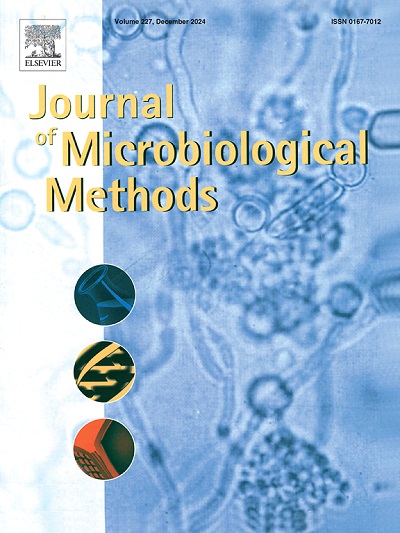Development of a high-throughput method for processing sponge-stick samples to detect viable Bacillus anthracis spores
IF 1.7
4区 生物学
Q4 BIOCHEMICAL RESEARCH METHODS
引用次数: 0
Abstract
Since the national validation of the sponge-stick based method for detection of Bacillus anthracis spores in environmental samples, there have not been focused efforts to address the low throughput nature of the method, which processes only one sample at one time. Sample processing remains a serious bottleneck for rapidly analyzing large numbers of samples expected from a biological warfare attack. Therefore, we developed a high-throughput method to simultaneously process multiple sponge-stick samples to be better prepared for rapid response and recovery after wide area anthrax incidents. In this method, sponges are placed in 50 mL tubes containing 25 mL extraction buffer and shaken to release spores, after which the suspension is recovered for analysis. We determined that an additional extraction step, conducted in the same tubes with 10 mL buffer, further increased spore recovery from sponge-stick by approximately 10 %. We determined that orbital shaking and multi-tube vortexing were both more effective than reciprocating shaking for recovering spores. We conducted simultaneous processing of up to 12 sponge-stick samples and demonstrated comparable spore recovery efficiencies to the traditional low-throughput stomacher-based method (approximately 60 % recovery at 102-spore level and 75 % recovery at 104-spore level for both methods in three replicate experiments, P > 0.05 for two-tailed t-tests for each experiment and spore level). We also demonstrated that our high-throughput method could be integrated with Rapid Viability-Polymerase Chain Reaction (RV-PCR) analysis and could detect levels as low as 40 spores per sponge even when challenged by a PCR particulate contaminant.

开发一种高通量处理海绵棒样品以检测活的炭疽芽孢杆菌孢子的方法。
自海绵棒法检测环境样品中炭疽芽孢杆菌孢子的国家验证以来,一直没有集中努力解决该方法的低通量性质,该方法一次只能处理一个样品。样本处理仍然是快速分析来自生物战攻击的大量样本的严重瓶颈。因此,我们开发了一种高通量同时处理多个海绵棒样品的方法,以便更好地为广域炭疽事件后的快速反应和恢复做好准备。在这种方法中,将海绵放入含有25 mL萃取缓冲液的50 mL管中,摇晃以释放孢子,之后回收悬浮液进行分析。我们确定,在相同的管中使用10 mL缓冲液进行额外的提取步骤,进一步提高了海绵棒的孢子回收率约为10 %。我们确定轨道震动和多管涡旋都比往复震动更有效地恢复孢子。我们同时处理了多达12个海绵棒样品,并证明了与传统的低通量基于胃的方法相当的孢子回收率(在三个重复实验中,两种方法在102孢子水平上的回收率约为60 %,在104孢子水平上的回收率约为75 %,每个实验和孢子水平的双尾t检验P > 0.05)。我们还证明了我们的高通量方法可以与快速生存力-聚合酶链反应(RV-PCR)分析相结合,即使受到PCR颗粒污染物的挑战,也可以检测到每个海绵低至40个孢子的水平。
本文章由计算机程序翻译,如有差异,请以英文原文为准。
求助全文
约1分钟内获得全文
求助全文
来源期刊

Journal of microbiological methods
生物-生化研究方法
CiteScore
4.30
自引率
4.50%
发文量
151
审稿时长
29 days
期刊介绍:
The Journal of Microbiological Methods publishes scholarly and original articles, notes and review articles. These articles must include novel and/or state-of-the-art methods, or significant improvements to existing methods. Novel and innovative applications of current methods that are validated and useful will also be published. JMM strives for scholarship, innovation and excellence. This demands scientific rigour, the best available methods and technologies, correctly replicated experiments/tests, the inclusion of proper controls, calibrations, and the correct statistical analysis. The presentation of the data must support the interpretation of the method/approach.
All aspects of microbiology are covered, except virology. These include agricultural microbiology, applied and environmental microbiology, bioassays, bioinformatics, biotechnology, biochemical microbiology, clinical microbiology, diagnostics, food monitoring and quality control microbiology, microbial genetics and genomics, geomicrobiology, microbiome methods regardless of habitat, high through-put sequencing methods and analysis, microbial pathogenesis and host responses, metabolomics, metagenomics, metaproteomics, microbial ecology and diversity, microbial physiology, microbial ultra-structure, microscopic and imaging methods, molecular microbiology, mycology, novel mathematical microbiology and modelling, parasitology, plant-microbe interactions, protein markers/profiles, proteomics, pyrosequencing, public health microbiology, radioisotopes applied to microbiology, robotics applied to microbiological methods,rumen microbiology, microbiological methods for space missions and extreme environments, sampling methods and samplers, soil and sediment microbiology, transcriptomics, veterinary microbiology, sero-diagnostics and typing/identification.
 求助内容:
求助内容: 应助结果提醒方式:
应助结果提醒方式:


